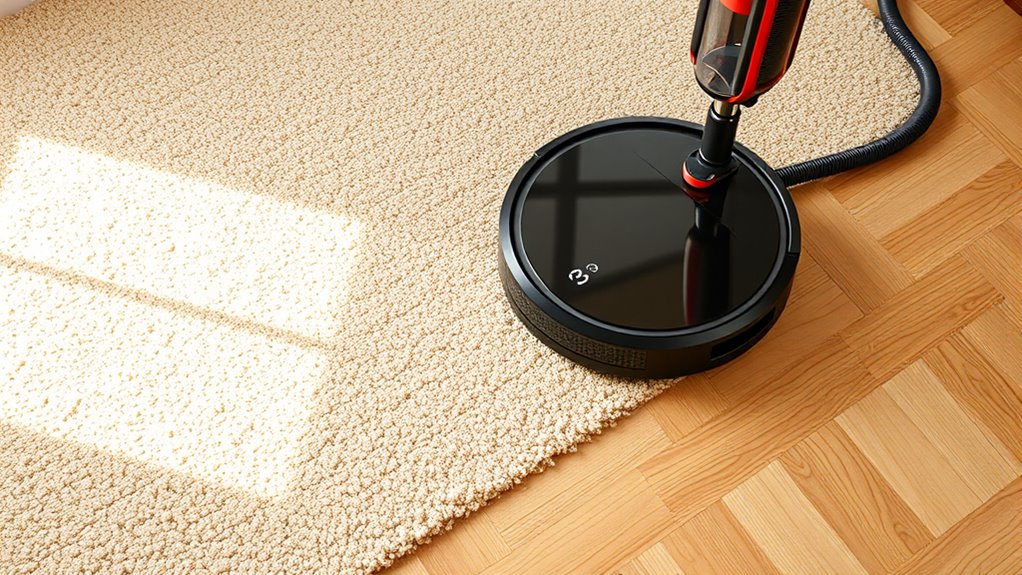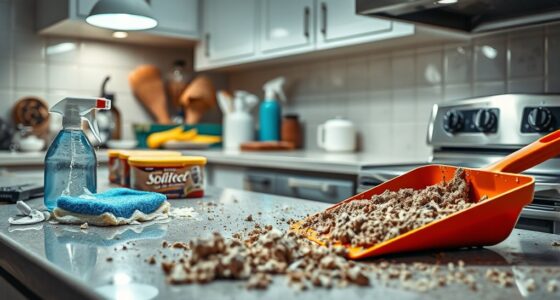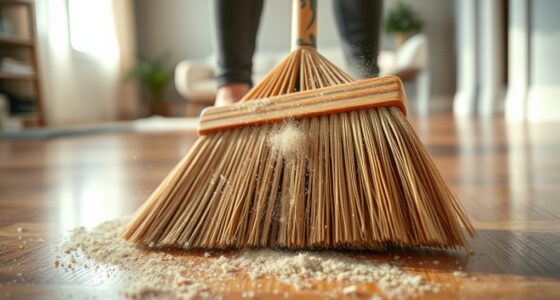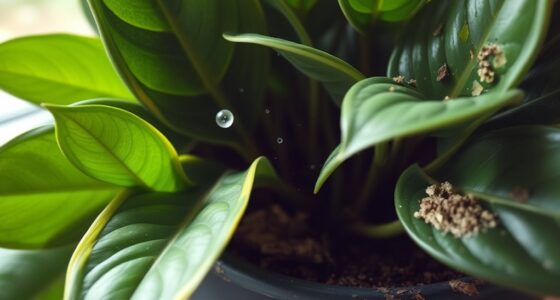Upright vacuums usually pick up more microscopic dust than robot models because they have stronger suction, bigger capacity, and can clean thoroughly in one pass. Robot vacuums are quieter and more convenient but often struggle with deep or tiny debris due to limited power and reach. If you want the best for microscopic dust, uprights tend to perform better. Keep exploring to discover which option suits your cleaning needs even better.
Key Takeaways
- Upright vacuums generally have stronger suction, making them more effective at picking up microscopic dust in a single pass.
- Robot vacuums, with smaller motors, may struggle to thoroughly remove tiny dust particles, often requiring multiple cleaning sessions.
- Larger dustbins in uprights allow for more extensive cleaning without frequent emptying, aiding in better microscopic dust removal.
- Uprights are better suited for deep cleaning of embedded and widespread microscopic debris due to their power and capacity.
- Robot vacuums operate quietly but may compromise thoroughness on microscopic dust compared to the more powerful uprights.
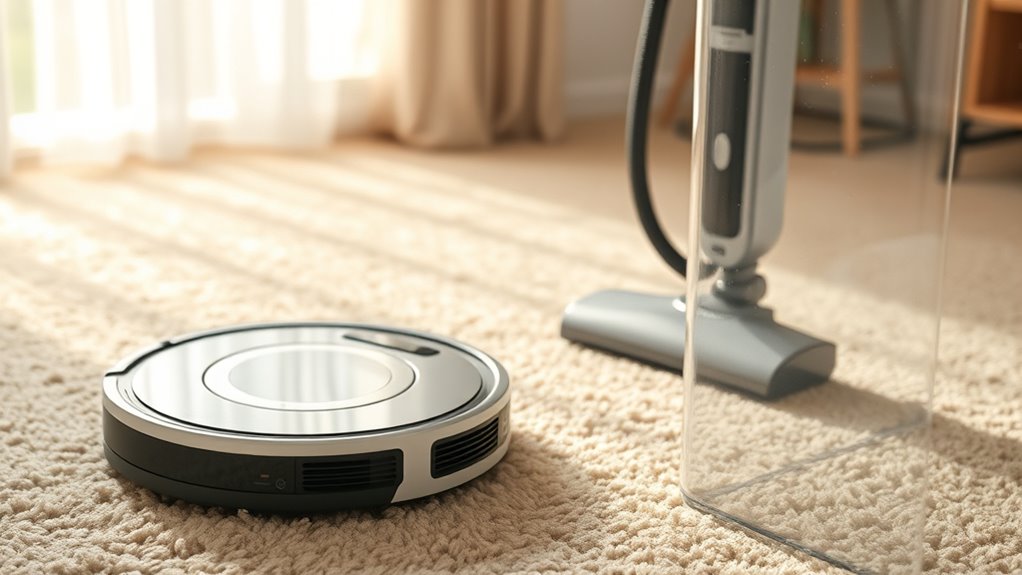
When it comes to cleaning your home, choosing between robot vacuums and upright models can be a tough decision. One of the key considerations is how well each type picks up microscopic dust, which can be sneaky and hard to eliminate. Robot vacuums are generally designed for convenience; they can run automatically and reach under furniture, but they often have limited battery life. If you have a large area to clean, you might find yourself needing to recharge or run multiple sessions with a robot vacuum. This limitation can impact their ability to thoroughly clean every corner, especially when it comes to tiny dust particles that settle deep within carpets or cracks. On the other hand, upright vacuums tend to have more powerful suction and larger dustbins, enabling them to pick up even the smallest dust particles more effectively in a single pass. Their corded design means you’re not limited by battery life, allowing for longer cleaning sessions without interruption. This makes them especially suitable if you’re concerned about microscopic dust accumulation over time. Additionally, the efficiency of vacuuming expert voice actors can enhance overall cleaning effectiveness, especially when targeting microscopic debris.
Noise levels are another important factor to take into account. Robot vacuums are generally quieter since they operate with smaller motors and are designed for minimal disturbance. If you want to run a vacuum while working or relaxing, a robot model can be a good choice because it won’t disrupt your day. However, some high-end robot vacuums can produce noticeable noise during intensive cleaning cycles, which might be distracting in quiet settings. Upright vacuums, although more powerful, tend to generate more noise because of their larger motors and the direct contact they make with surfaces. This might make them less ideal if quiet operation is a priority. Still, their noise can be tolerated if you want the best cleaning performance, especially when tackling dust that’s deeply embedded or widespread.
Frequently Asked Questions
How Do Robot Vacuums Perform on Different Floor Types?
You’ll notice that robot vacuums perform well across various floor types, but their efficiency depends on the floor shift and carpet suction power. On hard floors, they glide smoothly and pick up dust easily. On carpets, especially thicker ones, stronger carpet suction helps lift microscopic dust effectively. Make sure your robot adjusts to different surfaces, so it cleans thoroughly, whether it’s moving from tile to carpet or hardwood to rug.
Can Robot Vacuums Replace Traditional Upright Cleaners Entirely?
You might wonder if robot vacuums can fully replace traditional uprights. While they offer cordless convenience and excel in quick clean-ups, they often lack the battery longevity needed for deep cleaning sessions. Uprights still deliver stronger suction and better dust removal for thorough cleaning. For everyday maintenance, robot vacuums are great, but for heavy-duty tasks, upright cleaners remain essential. Combining both gives you maximum cleaning efficiency.
What Maintenance Is Required for Optimal Dust Collection?
You might think maintaining your vacuum is a chore, but it’s actually your secret weapon against microscopic dust. Regularly replace filters to keep suction strong and guarantee your robot or upright isn’t just stirring up dirt. Don’t forget to brush maintenance—removing hair and debris prevents clogs. With these simple steps, you’ll maximize dust collection, making your cleaning routine a breeze and your home noticeably cleaner, dust-free, and fresh.
Are Robot Vacuums Suitable for Allergy Sufferers?
If you’re an allergy sufferer, robot vacuums can be a good choice, especially with HEPA filtration. They trap allergy triggers like dust mites and pollen effectively, reducing airborne particles. You should choose a model with a true HEPA filter for peak performance. Regular maintenance, like changing filters and emptying the dustbin, ensures they continue to help control allergens and keep your home more comfortable.
How Do Noise Levels Compare Between Robot Vacuums and Uprights?
Imagine quiet mornings, peaceful afternoons, and restful nights—noise comparison matters. Robot vacuums typically operate at lower volume levels, offering a gentle hum that barely disturbs your day. Uprights, on the other hand, often produce louder sounds due to powerful motors, which can be disruptive. So, if you prefer serenity, robot vacuums provide a quieter cleaning experience. Their lower volume levels make them ideal for maintaining a calm, undisturbed environment.
Conclusion
So, if you think robot vacuums can’t match the cleaning power of uprights, think again. They might pick up just as much microscopic dust, making them a smart choice for daily maintenance. Plus, they save you time and effort. Even if you prefer traditional vacuums for deep cleaning, incorporating a robot can keep those tiny particles at bay between sessions. Ultimately, it’s about balancing convenience with thoroughness for a cleaner home.
